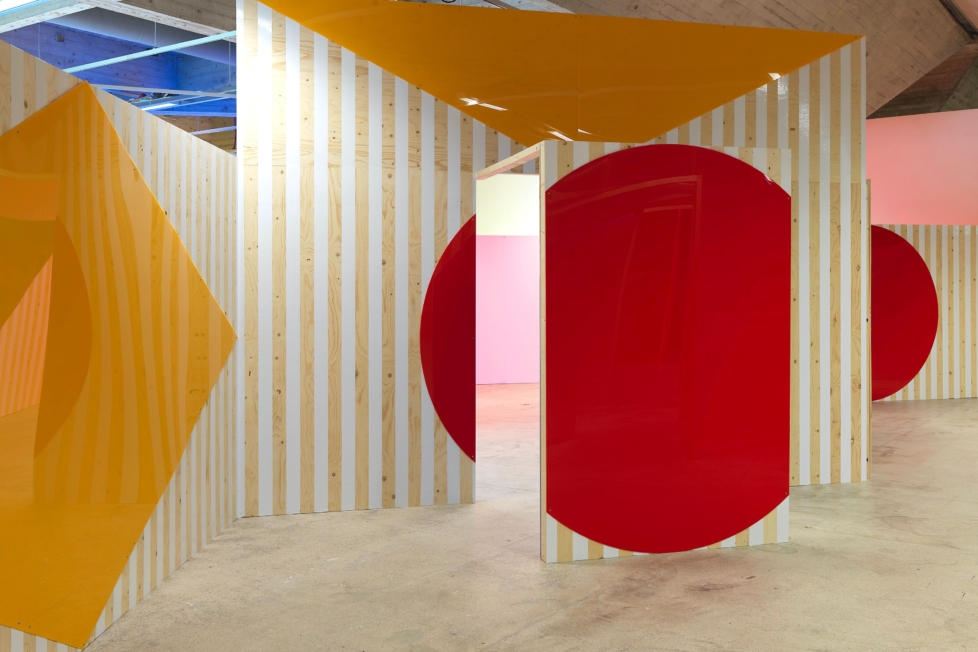
Daniel Buren’s exhibition Going for a Walk in a Zigzag at Espoo Museum of Modern Art (EMMA) is impossible to reflect upon without considering the reality that we currently inhabit. It was not Buren’s intention to create a political exhibition, but the experience is relentlessly coloured by the constant feelings of anxiety and helplessness that the war in Ukraine has brought on, amplified in Finland because of the lingering memory of the wars fought against the Soviet Union in the 1940s. Stepping into Buren’s colourful world is to confront your own mood and conscience.
In a video produced by the museum, a jovial Buren talks about how the physical exhibition space is always the starting point for his art. He argues that a traditional retrospective of his practice would be impossible as most of his work cannot me moved from one place to another. Buren keeps coming back to the term in situ, which for him seems to be the key to both his own creativity and his successful career. As a result, I get the impression that the museum approached the French maestro with a retrospective in mind. Well, that’s not what it got. Buren does not budge when it comes to the conviction that his works are – almost like occult objects – always linked to their original environment.

For visitors, this is a good thing. We are spared depressing striped paintings hung on bare walls and all the kinds of bright blocks and three-dimensional wall installations that Buren has produced during his long career – works better suited for a 1980s yuppie apartment than a family-friendly museum in the 2020s. Instead, we get a new site-specific installation, Les Paravents (Folding Screens, 2022), which offers a valuable opportunity, after the long pandemic period, to move in harmony with a work of art, to actually step into it.
Les Paravents is a labyrinth consisting of small rooms leading into one another. No two rooms are alike, and the mood shifts with each change in colour and lighting. It is a simple concept, the strength of which lies in what can only be described as Buren’s architectural vision. Carefully placed windows allow us to see through several rooms at once, a detail that adds a hint of voyeurism to the mix. The installation is so big that it’s impossible to get an overview of it in its entirety.
The experience made me think of the James Bond film The Man with the Golden Gun (1974), in which the villain Scaramanga’s idea of a perfect trap for an intruder is a deadly version of a funhouse, complete with distorting mirrors and surveillance cameras. The screenwriters’ wild invention manages to take advantage of the unpleasantness that bubbles beneath the cheerful surface of the carnivalesque. The same can be seen in Buren’s installation, which begins with selfie-friendly lighting and brightly coloured reflective acrylic walls then gradually turns into raw and monochrome metallic chambers. Just as in real funhouses, children will love this, while adults risk being overwhelmed by a sudden existential anxiety at the sight of their own distorted reflection.

Experiencing Les Paravents requires movement, and as I tried to coordinate and choreograph my route through the installation my thoughts about the war in Ukraine took on new forms. What in another context could have been a paltry Instagram work became a therapeutic experience: it calmed and anchored me in the moment, while also creating an overwhelming sense of absurdity. As I stood in the middle of the installation, it was impossible to escape what is going on in the world. Feelings of guilt and helplessness washed over me. Yet, it felt easier to confront them in these empty chambers, which are equally meditative and prickly.
When I stepped out of the labyrinth, I was confronted by a wall of windows which Buren has covered with colourful squares, like stained-glass windows designed by Malevich. Circumstance can turn the most unexpected experience into something sanctified.












